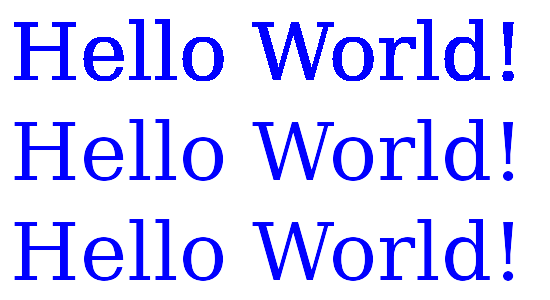Font - Basics
AGG draws font glyphs just like any path objects. Because of AGG's subpixel accuracy, that is all you need.
On linux, AGG uses FreeType library to get the font glyphs. It can be a bit tricky to get both FreeType and the right libpng installed. You may have to either upgrade the system or do custom compilation.
Loading a font is straight forward. See the code below. It should be noted that different Linux systems organize TrueType fonts differently. For this tutorial, we will just use DejaVuSerif.ttf in fonts/ directory.
agg::font_engine_freetype_int32 fontEngine;
agg::font_cache_manager<agg::font_engine_freetype_int32> fontCache (fontEngine);
// load font outline path
fontEngine.load_font(fontPath, 0, agg::glyph_ren_outline);
// enable hint
fontEngine.hinting(true);
// flip y since the image coordinate system has the origin at
// top left corner and y axis is flipped
fontEngine.flip_y(true);
// set font size
fontEngine.height(fontSize);
For actual text drawing, it is straightforward. Just get the glyph and draw the path, depending on the path type.
void
drawText (const char* str,
double x,
double y,
bool kerning,
agg::font_engine_freetype_int32& fontEngine,
agg::rgba8 color,
RendererBaseType& rBase)
{
bool first = true;
// these three are only needed for outline rendering
agg::conv_curve<agg::font_engine_freetype_int32::path_adaptor_type> curves(fontCache.path_adaptor());
agg::scanline_p8 scanline;
for (; *str != 0; ++str)
{
unsigned ch = *str;
const agg::glyph_cache* glyph = fontCache.glyph(ch);
if (glyph)
{
if (first)
{
first = false;
}
else
{
if (kerning)
{
fontCache.add_kerning(&x, &y);
}
}
fontCache.init_embedded_adaptors(glyph, x, y);
switch (glyph->data_type)
{
case agg::glyph_data_mono:
{
agg::render_scanlines_bin_solid(fontCache.mono_adaptor(), fontCache.mono_scanline(), rBase, color);
break;
}
case agg::glyph_data_gray8:
{
agg::render_scanlines_aa_solid(fontCache.gray8_adaptor(), fontCache.gray8_scanline(), rBase, color);
break;
}
case agg::glyph_data_outline:
{
ras.reset();
ras.add_path(curves);
agg::render_scanlines_aa_solid(ras, scanline, rBase, color);
break;
}
default:
{
}
}
x += glyph->advance_x;
y += glyph->advance_y;
}
}
}
Example
tutorial_font_1.cpp generates three rows of "Hello World!" text using different types of glyph rendering.
- agg::glyph_ren_agg_mono
- agg::glyph_ren_agg_gray8
- agg::glyph_ren_outline

